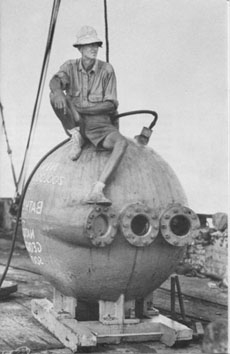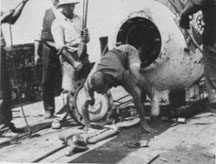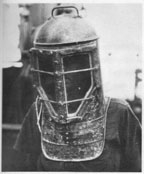 says that when she was young, she spent hours in her local library, poring over books. Her imagination was often piqued by the works of explorers such as Jacques Cousteau, who described how one's blood looked green underwater (she says that she couldn't wait to see for herself). Another person who inspired her to a life of deep-sea exploration and study was William Beebe, a scientist, explorer and naturalist, who made a world-famous expedition into the deep in his homemade "bathysphere."
says that when she was young, she spent hours in her local library, poring over books. Her imagination was often piqued by the works of explorers such as Jacques Cousteau, who described how one's blood looked green underwater (she says that she couldn't wait to see for herself). Another person who inspired her to a life of deep-sea exploration and study was William Beebe, a scientist, explorer and naturalist, who made a world-famous expedition into the deep in his homemade "bathysphere."
 |
Before the naturalist and explorer, William Beebe, and inventor Otis Barton made their foray into the deep in the spherical submarine called the "bathysphere," exploring the sea was a dangerous and awkward process. There are artists' renderings of bizarre creatures with human bodies and bottle-shaped heads from which rubbery hoses rose like misplaced elephants' trunks, stretching upward beyond the water's surface in order to connect the air-breathing biped to its only source of oxygen. The effect was rather eerie, and provided the diver with a limited range and capacity for movement.
The bathysphere itself was not perfect; the type of submersible that could carry its own oxygen supply had not yet been invented. But this device, invented by Otis Barton specifically for William Beebe, was an important intermediary step in the advancement of underwater exploration and would enable Beebe to make his most important expedition, the one that would make the 57-year-old naturalist famous throughout the world.
 |
Beebe had been working for the New York Zoological Society, travelling and studying animal life in the Galapagos Islands. He loved the sea animals and knew that the many species on the islands were but a portion of what he could find under the waves. The technology of the time, however, did not allow for deep sea exploration. He needed a way to dive without the correlated problems of having enough oxygen for a long submersion and also without the problems of enduring water pressure at the great depths he wished to explore. He announced his need and invited scientists to come up with some new technology. Many inventors wrote to him, offering ideas for various weird devices with which to dive. Finally, one device, presented by inventor Otis Barton, appeared to be the most useful and sound.
 |
Barton's concept was a spherical submersible, which he called the Bathysphere. It was this contraption that allowed Beebe to make his famous dive off the Bermuda Islands, in which he set a record by diving 3,028 feet. This was deeper than anyone before him. His expeditions, and the writings he left behind, have inspired generations of explorers.
Page created on 7/20/2004 9:54:16 AM
Last edited 2/22/2019 9:20:10 PM
Pheasant Jungles
A Monograph of the Pheasants
Galapagos - World's End
Jungle Days
Beneath Tropic Seas
Pheasants: Their Lives And Homes
A Monograph Of The Pheasants
His writing has also appeared in:
Ocean Planet: Writings and Images of the Sea
